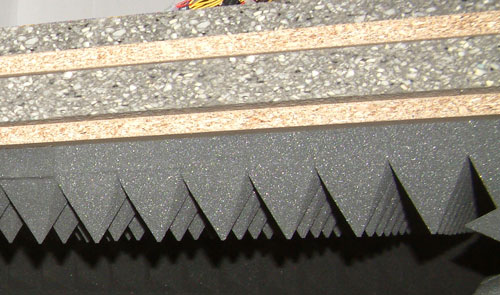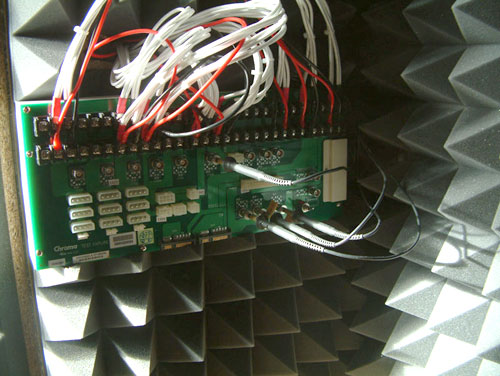Seasonic M12D 850W: DC-to-DC Perfection?
by Christoph Katzer on November 26, 2008 12:00 AM EST- Posted in
- Cases/Cooling/PSUs
Testing with the Chroma ATE Programmable Load

Our test equipment consists of two Chroma programmable DC Loads that enable us to test power supplies with an output of up to 1500W. The biggest advantage of the Chroma DC Loads is simply the high precision it provides. It can measure differences as small as 0.001V and 0.0001A, which will provide us with best-in-class results.
When programming the Chroma with specific amounts of load calculated according to the ATX norm, we are able to load power supplies to an exact percentage. We can now show results at every specific percentage needed. To get the best overview of a power supply, we load each unit with 10%, 20%, 50%, 80%, 100%, and 110% of the specified output. This is easy to calculate for a 1000W power supply: the 10% load is 100W and 110% load is 1100W. Remember that this is the amount of power the PSU delivers; due to inefficiencies, a power supply will actually draw more power from the wall.
Note: If you would like to know more about our testing methodology, equipment, and environment, please read our PSU testing overview.
We have added an additional 10% on the highest load to see how the units perform with overload. This test will be performed in all future reviews. The overload test is performed at room temperature as well as under more stressful conditions; to ensure we are not too cruel to the power supplies, we will keep the ambient temperature at 50°C in the stress test. Experience shows that many units can stand the overload at room temperature but will experience problems with higher temperature and overload together. Only the best-built units will survive this.

The Testing Environment
There is one flaw in testing power supplies with programmable loads while trying to measure the sound pressure levels at the same time. Because the programmable loads get very loud, there is no chance of hearing the power supply on the test stand. In order to make accurate measurements of the noise levels we needed a way to separate the test unit and the programmable loads. Our solution was to build a very thick box around the unit.

We concluded that a five-layer box with a total thickness of 6" (15cm) containing two layers of wood and three layers of special foam would suffice. It is designed as a box within a box. The inner box does not touch any part of the outer box, making it difficult for acoustic noise to pass through in the form of vibration. Each box is isolated on both sides with a layer of heavy foam that is normally used to insulate engines. On the inside we have an additional layer of 4" (10cm) thick pyramidal foam on every side of the box to eliminate the acoustic waves coming from the test object as well as we can.

To ensure a completely closed system we installed the printed circuit board that the connectors of the power supply are attached to inside the anechoic room/box. In other box designs, you would need to put all the cables through the wall. Unfortunately, that would result in the inside of the box not being fully isolated anymore. Our design keeps everything that needs to be connected inside of the box and maintains isolation.










45 Comments
View All Comments
JarredWalton - Wednesday, November 26, 2008 - link
I have no idea... I think I said "and they feature" perhaps? Heh. Go Dragon!Slash3 - Wednesday, November 26, 2008 - link
Argh! The fingers, use them! :) It's probably faster, too, after correcting two dozen mis-transcribes.JarredWalton - Thursday, November 27, 2008 - link
I would... but carpal tunnel issues make it a problem.BikeDude - Saturday, November 29, 2008 - link
Sorry to hear about your carpal tunnel issues.But I have always thought that such issues stems from mouse usage. So at work I use my left hand for moving the pointer, and at home the right hand.
Using a keyboard should not normally be much cause for concern?
JarredWalton - Wednesday, November 26, 2008 - link
Blame the editor (me) and my speech-recognition. Should have been "fails".PrinceGaz - Wednesday, November 26, 2008 - link
On page 3, about the cables, the speech-recognition software seems to have made another error[/quote]Most of the cables are detachable and come in an extra bag Seasonic provides. The 24-pin ATX connector, 4-pin ATX12V and 8-pin EPS12V connectors, 260cm 6-pin PEG connectors...[/quote]
I think that should read two 60cm 6-pin PEG connectors.
Zoomer - Thursday, November 27, 2008 - link
I thought someone was supposed to proof-read these. ;)feraltoad - Wednesday, November 26, 2008 - link
What speech recognition s/w do you use Jarred? Do you use it just for large amounts of text entry or is useful for other things like quick posts like this. Does it make things quicker? Or does fixing the errors eat up a lot of time? I guess you just save time and don't fix those errors. haha j/k!feraltoad - Wednesday, November 26, 2008 - link
Oh. U use Dragon. Well, other questions stand!